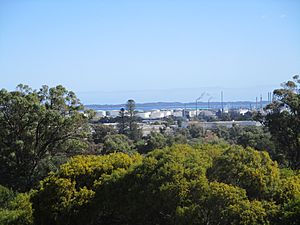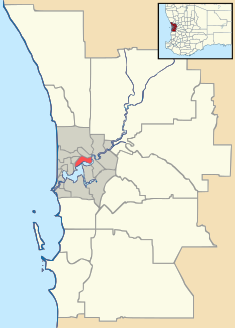Kwinana Oil Refinery facts for kids

Kwinana Oil Refinery, seen from Chalk Hill Lookout
|
|
| Country | Australia |
|---|---|
| City | Kwinana |
| Coordinates | 32°13′46″S 115°45′54″E / 32.2295°S 115.7649°E |
| Refinery details | |
| Owner(s) | BP |
| Commissioned | 1955 |
| Decommissioned | 2021 |
| Capacity | 138,000 bbl/d (21,900 m3/d) |
The Kwinana Oil Refinery was a large factory that made oil products. It was located in Kwinana, near Fremantle in Western Australia, right by the water called Cockburn Sound. The Anglo-Iranian Oil Company built it, and it opened in 1955. For a long time, it was the biggest oil refinery in Australia. It could process about 138,000 barrels of oil every day! BP, the company that owned it, closed the refinery in March 2021. Now, it's being changed into a place where oil products are just brought in and stored, not made.
History of the Kwinana Refinery
In March 1952, the government of Western Australia and the Anglo-Iranian Oil Company made a big deal. They agreed to build the Kwinana Oil Refinery. This plan was then sent to the parliament to become law. One part of the plan was about building the refinery. The other part was about getting the land needed in Kwinana.
Building the Refinery: Key Steps
The final agreement for the refinery included many important details. The company agreed to help pay for dredging (digging out the bottom) of Cockburn Sound. This was important so large ships could come and go. The state government promised to provide electricity, water, and sewerage for the new factory. They also agreed to build 1,000 homes for workers within three years.
Land for the Project
The government also set aside land for future industries. This land stretched from Robbs Jetty south towards Rockingham and east to Jandakot. The goal was to get this land at a fair price for development.
Federal Government's Role
The Federal Government also helped with the project. They agreed to sell back some land they owned in the area to the Western Australian government. This land, from Woodman Point down to Kwinana, would be used for industrial purposes. There were also talks about bringing in skilled workers from other countries to help build the refinery.
Getting Ready: Water, Dredging, and Rail
In May 1952, work began on a water pipeline. This pipeline would bring water from the Melville reservoir to a large storage tank in Henderson. This water was needed for the construction work.
Dredging the Sound
Companies were asked to bid for the job of dredging Cockburn Sound. This massive task would take several years. They needed to dig a wide and deep channel through two sandbanks, the Success Bank and the Parmelia Bank. This would allow very large ships, up to 40,000 tons, to enter Cockburn Sound.
Railway Connections
Plans were also made to extend the existing railway line. This new line would go from Woodman Point and Coogee to the refinery site. Later, the plan was changed to connect the refinery to a future railway line from Welshpool.
Construction Begins
In September 1952, the Anglo-Iranian Oil Company announced which companies would build the refinery. Kelloggs International and Costain-John Brown & Company were chosen for the job.
Official Start
The project officially began on October 9, 1952. The first contract for dredging was given to a Dutch company. They would create a 152-meter-wide, 11.5-meter-deep channel. This involved removing 7 million cubic yards of sand and mud. Tenders for building the 1,000 new rental houses for workers were also sent out in November 1952.
Opening the Refinery
The refinery's main office buildings were built between May and December 1954. On January 8, 1955, the first oil tanker, the British Crusader, arrived. It sailed through the new channels into Cockburn Sound on January 11.
First Oil and Petrol
The first oil was pumped into the refinery's machines on February 2, 1955, and the refinery started working. Petrol was pumped from the refinery for the first time on March 23, 1955. It went to a storage depot in North Fremantle. The refinery was officially opened on October 25, 1955, by the Governor-General, Sir William Slim.
Changing to an Import Terminal
After 65 years of making oil products, BP decided to stop refining oil in 2021. They said it was no longer making enough money. Instead, they planned to turn the site into an oil import terminal. This means oil products will be brought in from other places and stored there, but not made. The closure removed a lot of Australia's ability to make its own fuel. Kwinana used to supply about 70% of Western Australia's fuel. The number of workers at the site was also greatly reduced.
Engineering Heritage
The Kwinana Oil Refinery received a special award called a Historic Engineering Marker from Engineers Australia. This award is part of their program to recognize important engineering achievements.


